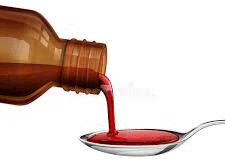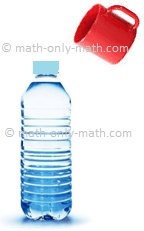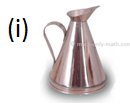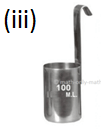Subscribe to our ▶️ YouTube channel 🔴 for the latest videos, updates, and tips.
Measuring Capacity
We will discuss about measuring capacity. Capacity of a container tells us how much liquid it can hold. We know that a large vessel can hold more liquid than a smaller vessel. So, we say that a large vessel has more capacity than the smaller vessel. We can measure the capacity of a vessel by using another vessel.
We have learnt that a bigger vessels has more capacity than the smaller vessel.
Look at the vessels shown below.
Which vessel do you think can hold the maximum liquid?
It is the tank.
Which vessel will hold the least quantity of liquid?
It is the spoon.
So, we can say that among the given vessels, the tank has the maximum capacity and the spoon has the least capacity.
To compare, the capacity of two vessels we use another smaller vessel.
Let us compare the capacity of a bottle and a jug.
We take a cup and pour water to fill the jug. We note the number of times we poured the water with the cup to fill the jug.
We repeat this to fill the bottle using the same cup.
On comparing the number of times the cup was used for filling the bottle and the jug, we can say which vessel has more capacity.
In the above example, suppose a bottle holds 6 cups and the jug holds 5 cups, we can say that capacity of jug is about 5 cups and bottle is about 6 cups.
There are two jars A and B. Which holds more water?
To find out which of the jars holds more water, we pour water from both the jars into identical containers. Water from Jar A fills one glass. Water from Jar B fills two glasses. So Jar B can hold more water than Jar A. Thus, Jar B has more capacity than Jar A.
A tablespoon has more capacity than a teaspoon. Let us verify this.
We find that 3 teaspoonful of water fills 1 tablespoon.
It takes 2 tablespoonful of water to fill the beaker up to 10 mark.
How much water is required to fill the beaker up to 40 mark?
_____ tablespoons
Again,
Take a cup and a jug.
Fill the cup with water and pour it in the jug.
Repeat this activity as many times as you can to fill the jug completely.
Suppose you had to perform the activity 7 times. Then we say that the capacity of the jug is 7 times the capacity of the cup.
If we observe two given containers carefully, we can easily tell which one has greater capacity.
For example, the capacity of the beaker is greater than the capacity of the glass.
Thus, we can say the quantity of liquid a container can hold is called it capacity.
Standard Units of Capacity:
The standard unit for measuring capacity is litre.
Its symbol is ℓ.
We use it for measuring large capacities such as that of a big bottle, a bucket or a water tank.
For measuring smaller capacities such as that of a cup, a glass or a small bottle, we use a smaller unit called millilitre (m).
 |
A teaspoon can hold around 5 mℓ liquid medicine! |
Litre and Millilitre
If we perform the same activity using another vessel, we will get different answer. Therefore, we need to use standard measures to find the capacity of a vessel. The standard unit of measuring capacity is the litre, we write 'l' for litre. Litre is used to measure capacity of larger containers like bucket or a bathtub.
Smaller quantities of liquids are measured in millitres, we write ml for millilitres.
1 litre = 1000 millilitres. If capacity of a bucket is 10 litres it is written as 10 l.
If capacity of a small bottle is 100 millilitres it is written as 100 ml.
The milkman measures milk in liters. Petrol is given in liters. Mobil oil is sold in liters. Two milk bottles contain 1 liter of milk. One milk bottle contains half liter.
The unit for measuring liquids is a liter. Small quantities of a liquid such as medicine are measured in milliliters.
1 liter = 1000 milliliters
or
1000 milliliters = 1 liter
The short way of writing liter is 'l' and milliliter is ‘ml’. So we can write in short as;
1 l = 1000 ml
or
1000 ml = 1 l
The milkman uses different types of cans to measure the milk like 1 l, 500 ml, 200 ml, 100 ml, 50 ml, etc.
Various types of measuring jars are used to measure different liquids.
Some are given below.
Liquids like water, milk and oil are usually measured using measuring cans.
The unit of capacity is litre. We write ℓ for litre.
Millilitre is a unit for measuring smaller amounts. We write me for millilitre.
The jug contains _____ litres of water.
The glass contains _____ millilitres of water.
A millilitre is a smaller measure than a litre.
Remember:
Capacity of a container is the amount it can hold.
The capacity of a big vessel is expressed in litres.
The capacity of a small vessel is expressed in millilitres.
We denote: (i) Litres by ℓ
(ii) millilitres by mℓ.
1 litre = 1000 millilitres
1 ℓ = 1000 mℓ
The quantity of liquid a vessel can hold is its capacity.
● These vessels are used to measure the quantity of milk and cooking oil etc.
● These vessels are used to measure the quantity of diesel, kerosene oil and petrol etc.
Questions and Answers on Measurement of Capacity:
I. Write T for true and F for false.
(i) We write ml for litres
(ii) 1000 ml = 1 l
(iii) Smaller quantities of liquids are measured in ml.
(iv) 500 ml is less than 1 l.
Answer:
I. (i) F
(ii) T
(iii) T
(iv) T
II. Fill in the blanks:
(i) A jug can hold 5 cups of water. The capacity of the jug is ............. cups.
(ii) Capacity of a bathtub can be measured in ............. (ml/l)
Answer:
II. (i) 5
(ii) l
III. Match the following:
Answer:
(i) → 2
(ii) → 3
(iii) → 1
IV. If the capacity of a bucket is 10 litres and the capacity of a jug 1 litre, which container is larger? .............
Answer: bucket
V. Arrange the following containers from the least capacity to the highest capacity.
Answer:
(vii) < (v) < (i) < (vi) < (ii) < (iii) < (viii) < (iv)
VI. Fill in the blanks:
(i) The capacity of a spoon is measured in ............. (ml/l)
(ii) The capacity of a bucket is measured in ............. (ml/l)
(iii) The capacity of a inkbottle is measured in ............. (ml/l)
(iv) The capacity of a swimming pool is measured in ............. (ml/l)
Answer:
(i) mℓ
(ii) ℓ
(iii) mℓ
(iv) ℓ
VII. Gary has a bottle which looks same as Sam's bottle. Gary's bottle can hold about 3 glasses of water whereas Sam's bottle can hold about 2 glasses of water. Whose bottle has more capacity?
Answer: Gary
VIII. Write 1, 2, 3 and 4 in the boxes, starting with 1 for the bottle having the largest amount of juice and 4 for the bottle having the least amount of juice.
IX. Fill in the blanks:
(i) A jug is filled completely with 15 cups of water, then capacity of the jug is __________.
(ii) 10 glasses of water are needed to fill a vessel, then capacity of the vessel is __________.
(iii) A bucket is filled completely with 20 mugs of water, then capacity of the bucket is __________.
Answer:
IX. (i) 15 cups or 15 times the capacity of the cup.
(ii) 10 glasses or 10 times the capacity of the glass.
(iii) 20 mugs or 20 times the capacity of the mug.
X. Are these quantities small or large? Decide whether you would measure these quantities in mℓ or ℓ:
(i) A tube of paint _____.
(ii) A bottle of ink _____.
(iii) Water in a small vase _____.
(iv) Milk in a baby's feeding bottle _____.
(v) Water in a large can Walter _____.
(vi) A drum of oil _____.
(vii) Medicine in an injection _____.
(viii) A bathtub full of water _____.
Answer:
X. (i) mℓ
(ii) mℓ
(iii) ℓ
(iv) mℓ
(v) ℓ
(vi) ℓ
(vii) mℓ
(viii) ℓ
Extra questions for sharp students on measuring capacity.
1. A bucket contains 15 l of water and another bucket contains 12 l. Find the total amount of water in the two buckets.
Answer: 27 ℓ
2. A goat gives 8 liters of milk every day. How much milk will the goat give in a week?
Answer: 56 ℓ
3. A dairy farm sells 145 liters of milk everyday. How much milk will it sell in 4 days?
Answer: 580 ℓ
4. A car covers 52 kilometers and a scooter 15 kilometers in one liter of petrol. Which vehicle covers more and by how much?
Answer: Car, 37 ℓ
5. A bottle contained 400 ml of oil. The bottle fell and 75 ml of oil dropped on the ground. How much oil was left in the bottle?
Answer: 325 mℓ
6. A bucket can contain 18 liters of water. A tank is filled full by 9 such buckets. How much water does the full tank contain?
Answer: 162 ℓ
Challenging Questions on Measuring Capacity:
|
(i) |
 |
= _____ mugs |
Answer:
(i) 2
(ii) 1
(iii) 8
1. What is the unit for measuring liquid?
1. What is the unit for measuring liquid?
Answer:
The unit for measuring liquids is litre. The short way of writing litre is ℓ.
The milkman measures milk in litres. Petrol and Kerosene oil are also sold in litres.
Small quantities of a liquid such as medicine are measured in millilitres. The short way of writing millilitre is mℓ.
1000 millilitres make 1 litre. In short, 1 ℓ = 1000 mℓ
From Measuring Capacity to HOME PAGE
Didn't find what you were looking for? Or want to know more information about Math Only Math. Use this Google Search to find what you need.



























New! Comments
Have your say about what you just read! Leave me a comment in the box below. Ask a Question or Answer a Question.